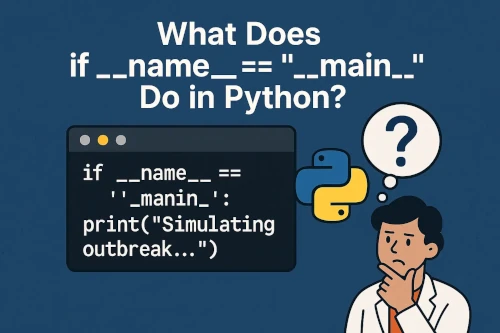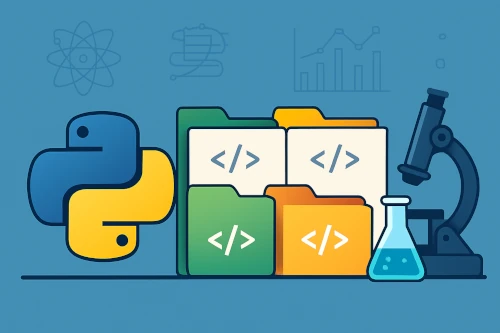
Using argparse: Making Your Python Scripts Smarter with Command-Line Arguments
You've written a brilliant Python script to analyze your research data. It works perfectly! But then your supervisor asks: "Can you run this with different parameters?" or "What if we use a different input file?"
Your heart sinks. Do you really have to edit the script every single time? 😤
Enter argparse—Python's built-in solution for making your scripts flexible and professional. Instead of hardcoding values, you can pass them as command-line arguments.
What Is argparse?
argparse lets you turn scripts like this:
python analyze_data.pyInto powerful, configurable tools like this:
python analyze_data.py --input data.csv --output results.png --threshold 0.05Your script becomes like a Swiss Army knife—one tool, many configurations.
A Simple Example: Data Analysis Script
Let's say you have a script that analyzes survey data:
import pandas as pd
import matplotlib.pyplot as plt
# Hardcoded values - not flexible!
input_file = "survey_data.csv"
output_file = "results.png"
significance_level = 0.05
data = pd.read_csv(input_file)
# ... do some analysis ...
plt.savefig(output_file)Here's how to make it flexible with argparse:
import argparse
import pandas as pd
import matplotlib.pyplot as plt
def main():
# Create the parser
parser = argparse.ArgumentParser(description='Analyze survey data')
# Add arguments
parser.add_argument('--input', required=True,
help='Input CSV file path')
parser.add_argument('--output', default='results.png',
help='Output image file path')
parser.add_argument('--threshold', type=float, default=0.05,
help='Significance threshold (default: 0.05)')
# Parse the arguments
args = parser.parse_args()
# Use the arguments
data = pd.read_csv(args.input)
# ... do analysis with args.threshold ...
plt.savefig(args.output)
if __name__ == '__main__':
main()Now you can run it with different parameters:
python analyze_data.py --input experiment_1.csv --output exp1_results.png
python analyze_data.py --input experiment_2.csv --output exp2_results.png --threshold 0.01Types of Arguments
Required arguments:
parser.add_argument('--input', required=True)Optional with defaults:
parser.add_argument('--output', default='results.png')Different data types:
parser.add_argument('--threshold', type=float, default=0.05)
parser.add_argument('--iterations', type=int, default=1000)
parser.add_argument('--verbose', action='store_true') # Boolean flagPositional arguments (no -- needed):
parser.add_argument('input_file', help='Path to input file')Real Research Examples
Climate Model Script:
python climate_model.py --start-year 2000 --end-year 2020 --scenario RCP45 --output-dir results/Machine Learning Training:
python train_model.py --data training_data.csv --epochs 100 --learning-rate 0.001 --model-type lstmStatistical Analysis:
python stats_analysis.py survey_responses.csv --test t-test --alpha 0.01 --save-plotsAdvanced Features
Choices (restrict to specific values):
parser.add_argument('--model', choices=['linear', 'polynomial', 'exponential'])Multiple values:
parser.add_argument('--files', nargs='+', help='One or more input files')Grouped arguments:
group = parser.add_mutually_exclusive_group()
group.add_argument('--verbose', action='store_true')
group.add_argument('--quiet', action='store_true')Pro Tips for Researchers
1. Add helpful descriptions:
parser = argparse.ArgumentParser(
description='Analyze protein folding simulation data',
epilog='Example: python analyze.py --input sim_data.pdb --cutoff 5.0'
)2. Use meaningful argument names:
--input-fileinstead of-i--significance-levelinstead of--alpha
3. Provide defaults that make sense:
parser.add_argument('--output-dir', default='./results',
help='Output directory (default: ./results)')4. Validate your arguments:
args = parser.parse_args()
if args.threshold < 0 or args.threshold > 1:
parser.error("Threshold must be between 0 and 1")The Magic --help Flag
Here's the best part: argparse automatically creates help documentation!
python analyze_data.py --helpReturns:
usage: analyze_data.py [-h] --input INPUT [--output OUTPUT] [--threshold THRESHOLD]
Analyze survey data
optional arguments:
-h, --help show this help message and exit
--input INPUT Input CSV file path
--output OUTPUT Output image file path
--threshold THRESHOLD Significance threshold (default: 0.05)TL;DR
argparsemakes scripts flexible without editing code- Use
parser.add_argument()to define what arguments you accept - Access arguments with
args.argument_name - You get automatic
--helpdocumentation for free - Perfect for research scripts that need different parameters
When NOT to Use argparse
For simple, one-off scripts that you'll never need to modify, hardcoded values are fine. But if you find yourself editing the same script repeatedly, it's time for argparse!
Final Thought
argparse transforms your scripts from rigid, single-use tools into flexible, professional-grade programs. Your collaborators will be impressed, your future self will be grateful, and your research will be more reproducible.
Start adding command-line arguments to your next script—you'll wonder how you ever lived without them!
Happy coding! ⚡





